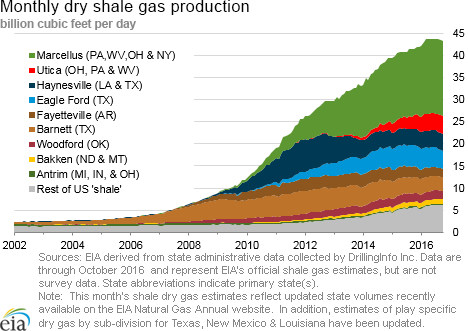In the News:
Unseasonably warm weather reduces U.S. heating demand
For the first time since April, weekly residential/commercial consumption of natural gas exceeded power burn. Over the past five years (2011–15), this transition in demand has occurred at the end of October on average, but this year the switch in primary consuming sector occurred several weeks later than in past years. Residential/commercial consumption in the Lower 48 states averaged 28 billion cubic feet per day (Bcf/d) during the week ending Thursday, November 24, and power burn averaged 22 Bcf/d, according to data from PointLogic.
Natural gas demand is largely driven by electricity generation fuel needs in the summer and heating needs in the winter. Electricity demand typically declines in the fall as the number of cooling degree days (CDD) tapers off. At the same time, the number of heating degree days (HDD) begins to rise as temperatures drop below 65°F. Temperatures since the beginning of September 2016 have been significantly warmer than in the past five years. The number of population-weighted HDD from September 1 through November 24 was 17% lower than last year and 28% lower than the five-year (2011–15) average for the same period. Over this same period, the weekly residential/commercial consumption of natural gas has remained at least 4% below the five-year average.
Conversely, weekly power burn has remained 8% or more above the five-year average, due to both additional cooling demand and the increased share of electricity generated by natural gas. The number of population-weighted CDD from September 1 through November 24 was 17% higher than last year and 31% higher than the five-year average over the same period. In addition to higher-than-normal temperatures, new natural gas-fired power plants have continued to come online and natural gas prices have been relatively low, incentivizing increased use of natural gas to generate electricity at the expense of other fuels.
Overview:
(For the Week Ending Wednesday, November 30, 2016)
- Natural gas spot prices rose at most locations this report week (Wednesday, November 23 to Wednesday, November 30). The Henry Hub spot price rose from $2.74 per million British thermal units (MMBtu) last Wednesday to $3.29/MMBtu yesterday.
- At the New York Mercantile Exchange (Nymex), the December 2016 contract expired Monday at $3.232/MMBtu. The January 2017 contract increased through the week to $3.352/MMBtu, up 21¢ Wednesday to Wednesday.
- Net withdrawals from working gas totaled 50 billion cubic feet (Bcf) for the week ending November 25. Working natural gas stocks are 3,995 Bcf, which is 1% greater than the year-ago level and 6% greater than the five-year (2011–15) average for this week.
- The natural gas plant liquids composite price at Mont Belvieu, Texas, rose by 22¢, closing at $5.64/MMBtu for the week ending November 25. The prices of natural gasoline, ethane, and isobutane all rose by 4%, and the prices of propane and butane rose by 3% and 6%, respectively.
- According to Baker Hughes, for the week ending Friday, November 25, the natural gas rig count increased by 2 to 118. The number of oil-directed rigs rose by 3 to 474. The total rig count climbed by 5, and it now stands at 593.
Prices/Supply/Demand:
Price movements up at most locations this week. This report week (Wednesday, November 23 to Wednesday, November 30), the Henry Hub spot price rose 55¢ from $2.74/MMBtu last Wednesday to $3.29/MMBtu yesterday. Prices increased at many trading locations at the end of the report week. Some market analysts cited forecasts of colder weather and predictions of a larger-than-average storage draw as reasons for the price increases. At the Chicago Citygate, prices increased 59¢ to $3.29/MMBtu yesterday. Prices at PG&E Citygate in Northern California gained 41¢, to $3.60/MMBtu yesterday. The price at SoCal Citygate rose 68¢ to settle at $3.50/MMBtu yesterday.
The Tallgrass Rockies Express Pipeline received approval from the Federal Energy Regulatory Commission on Monday to place its Zone 3 expansion project in service, sending additional gas from Ohio to points west along the pipeline. This project will increase capacity from 1.8 Bcf/d to 2.6 Bcf/d for delivery into Midwestern markets through the addition and enhancement of several compressor stations.
Northeast prices mixed. At the Algonquin Citygate, which serves Boston-area consumers, prices were essentially flat, falling 2¢ to $2.94/MMBtu yesterday. The Algonquin price was elevated at the start of the report week because of cold weather in the Northeast between November 21 and 23. At the Transcontinental Pipeline Zone 6 trading point for New York, prices increased 55¢ to $2.91/MMBtu yesterday, and are now quite close to Algonquin prices.
Tennessee Zone 4 Marcellus spot prices advanced 22¢ to $2.32/MMBtu yesterday. Prices at Dominion South in northwest Pennsylvania fell 5¢ to $2.22/MMBtu yesterday.
Futures prices up. At the Nymex, the December 2016 contract expired Monday at $3.232/MMBtu, up 21¢ from last Wednesday. The January 2017 contract increased to $3.352/MMBtu, up 21¢ from last Wednesday to yesterday. The price of the 12-month strip, averaging January 2017 through December 2017 futures contracts, climbed 11¢ to $3.293/MMBtu.
Supply remains flat. According to data from PointLogic, the average total supply of natural gas remained the same as the previous report week at 77.4 Bcf/d. Dry natural gas production remained constant week over week. Average net imports from Canada increased by 2% from last week.
Demand up. Total U.S. consumption of natural gas fell by 3% compared with the previous report week, according to data from PointLogic. Power burn decreased by 3%, industrial sector consumption decreased by 1%, and residential and commercial sector consumption decreased by 5%. Natural gas exports to Mexico were essentially flat, increasing by 1%.
U.S. liquefied natural gas (LNG) exports. The natural gas pipeline flows to Sabine Pass liquefaction terminal averaged 1.4 Bcf/d, 4% lower than flows last week. Two vessels (combined LNG-carrying capacity 6.7 Bcf) departed the terminal during last week, and one vessel (LNG-carrying capacity 3.5 Bcf) is currently loading at the terminal. Sabine Pass exported ten LNG cargoes in November, setting a new record for U.S. waterborne LNG monthly exports to-date. The previous record was set in August, with eight exported cargoes, totaling 26 Bcf.
The United States was a net exporter of natural gas for the week. For this report week, the United States imported a net average of 4.9 Bcf/d from Canada, and exported a net average of 5.1 Bcf/d as pipeline exports to Mexico and as LNG exports to other countries.
Storage:
Working gas stocks post largest net withdrawals of 2016–17 heating season. Net withdrawals from storage totaled 50 Bcf, compared with the five-year (2011–15) average net withdrawal of 44 Bcf and last year's net withdrawals of 35 Bcf during the same week. This week's net withdrawals follow last week's net withdrawals of 2 Bcf, and herald the unofficial beginning of the 2016–17 heating season. The heating season traditionally begins on November 1, and continues through March 31. However, in recent years, net injections into storage have continued into mid-November. Posting back-to-back net weekly withdrawals suggests that the withdrawal season is under way. Working gas stocks total 3,995 Bcf, which is 235 Bcf more than the five-year average and 24 Bcf more than last year at this time.
Net withdrawals from storage in the East and Midwest regions drive national withdrawals. The East and Midwest regions each posted net withdrawals totaling 23 Bcf. In both regions, these withdrawals exceeded the five-year average, topping the average pull of 13 Bcf in East region and 20 Bcf in the Midwest region. Working gas stocks in the East region are 1% below last year's level and 1% above the five-year level for this time of year. The Midwest region is 16 Bcf above its five-year maximum for this time of year, which was set in 2015. The Mountain region also posted a net withdrawal on the week and remains 30 Bcf above its five-year maximum. The Pacific region posted no net change during the report week and remains 10% below its five-year average, in large part because of inventory restrictions on the Aliso Canyon facility.
South Central region posts first net withdrawals of the season, despite continued injections at salt facilities. Net withdrawals totaled 3 Bcf in the South Central region, with nonsalt dome facilities accounting for net withdrawals of 7 Bcf, while salt dome companies had net injections of 4 Bcf. Working gas stocks in the South Central region are 12% higher than the five-year average for this time of year.
Net injections are in line with market expectations. Estimates of net withdrawals from storage ranged from 45 Bcf to 65 Bcf, with a median of 51 Bcf. The price of the Nymex futures contract for January delivery at the Henry Hub varied within 1¢/MMBtu of $3.45/MMBtu within two minutes of the release of EIA's Weekly Natural Gas Storage Report (WNGSR). Fewer than 200 trades occurred at the release of the WNGSR.
Temperatures were lower than last week and remain higher than normal. Temperatures in the Lower 48 states averaged 45°F, 1°F higher than the normal and the same as last year at this time. Cooling degree days (CDD) in the Lower 48 states totaled two, compared to three last year and compared to a normal of three. Heating degree days (HDD) in the Lower 48 states totaled 142, compared with 146 last year and a normal of 150.
See also:
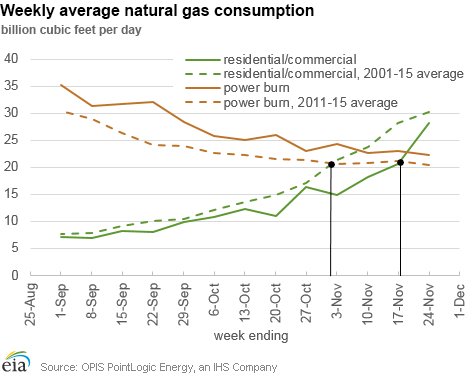
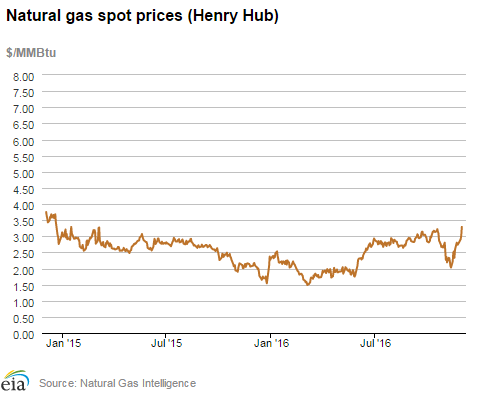
| Spot Prices ($/MMBtu) | Thu, 24-Nov |
Fri, 25-Nov |
Mon, 28-Nov |
Tue, 29-Nov |
Wed, 30-Nov |
|---|---|---|---|---|---|
| Henry Hub | Holiday |
Closed |
2.91 |
3.03 |
3.29 |
| New York | Holiday |
Closed |
2.4 |
2.25 |
2.91 |
| Chicago | Holiday |
Closed |
2.94 |
3.14 |
3.29 |
| Cal. Comp. Avg.* | Holiday |
Closed |
3.25 |
3.31 |
3.37 |
| Futures ($/MMBtu) | |||||
| December Contract | Holiday |
Closed |
3.232 |
Expired |
Expired |
| January Contract | Holiday |
Closed |
3.320 |
3.315 |
3.352 |
| February Contract | Holiday |
Closed |
3.346 |
3.341 |
3.359 |
| *Avg. of NGI's reported prices for: Malin, PG&E Citygate, and Southern California Border Avg. | |||||
| Source: NGI's Daily Gas Price Index | |||||
| Spot Prices ($/MMBtu) | Thu, 17-Nov |
Fri, 18-Nov |
Mon, 21-Nov |
Tue, 22-Nov |
Wed, 23-Nov |
|---|---|---|---|---|---|
| Henry Hub | 2.33 |
2.58 |
2.8 |
2.74 |
2.74 |
| New York | 1.83 |
2.41 |
2.93 |
2.61 |
2.36 |
| Chicago | 2.27 |
2.56 |
2.82 |
2.77 |
2.7 |
| Cal. Comp. Avg.* | 2.81 |
2.73 |
2.70 |
2.31 |
2.20 |
| Futures ($/MMBtu) | |||||
| December Contract | 2.703 |
2.843 |
2.950 |
2.982 |
3.026 |
| January Contract | 2.875 |
2.980 |
3.077 |
3.100 |
3.147 |
| *Avg. of NGI's reported prices for: Malin, PG&E Citygate, and Southern California Border Avg. | |||||
| Source: NGI's Daily Gas Price Index | |||||
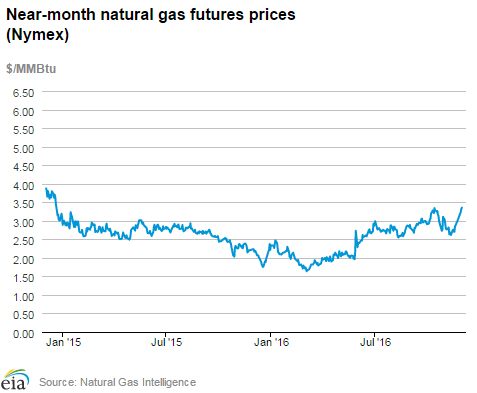
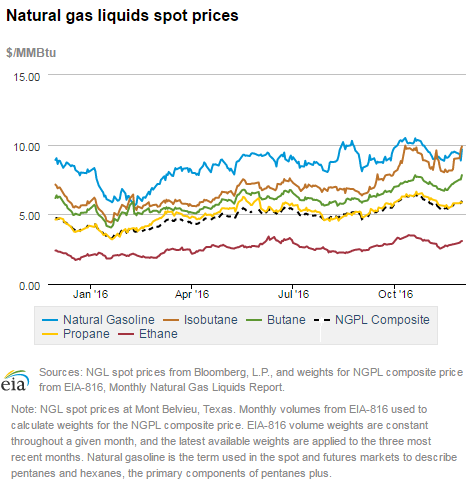
| U.S. natural gas supply - Gas Week: (11/25/16 - 12/1/16) | |||
|---|---|---|---|
Average daily values (Bcf/d): |
|||
this week |
last week |
last year |
|
| Marketed production | 80.5 |
80.6 |
81.7 |
| Dry production | 72.3 |
72.4 |
73.7 |
| Net Canada imports | 4.9 |
4.8 |
5.3 |
| LNG pipeline deliveries | 0.2 |
0.2 |
0.2 |
| Total supply | 77.4 |
77.4 |
79.2 |
|
Source: OPIS PointLogic Energy, an IHS Company | |||
| U.S. natural gas consumption - Gas Week: (11/25/16 - 12/1/16) | |||
|---|---|---|---|
Average daily values (Bcf/d): |
|||
this week |
last week |
last year |
|
| U.S. consumption | 70.0 |
72.3 |
74.4 |
| Power | 21.6 |
22.2 |
23.0 |
| Industrial | 21.6 |
21.8 |
21.8 |
| Residential/commercial | 26.8 |
28.2 |
29.6 |
| Mexico exports | 3.7 |
3.7 |
3.1 |
| Pipeline fuel use/losses | 6.5 |
6.8 |
6.9 |
| LNG pipeline receipts | 1.4 |
1.4 |
0.0 |
| Total demand | 81.6 |
84.2 |
84.3 |
|
Source: OPIS PointLogic Energy, an IHS Company | |||
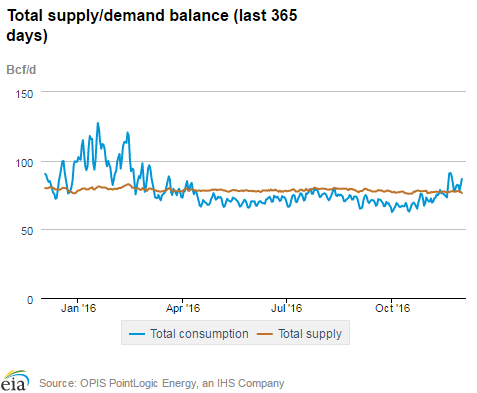
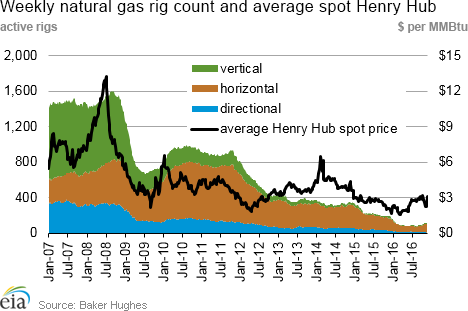
| Rigs | |||
|---|---|---|---|
Fri, November 25, 2016 |
Change from |
||
last week |
last year |
||
| Oil rigs | 474 |
0.6% |
-14.6% |
| Natural gas rigs | 118 |
1.7% |
-37.6% |
| Miscellaneous | 1 |
0.0% |
0.0% |
| Rig numbers by type | |||
|---|---|---|---|
Fri, November 25, 2016 |
Change from |
||
last week |
last year |
||
| Vertical | 66 |
0.0% |
-39.4% |
| Horizontal | 475 |
1.1% |
-16.5% |
| Directional | 52 |
0.0% |
-21.2% |
| Source: Baker Hughes Inc. | |||
| Working gas in underground storage | ||||
|---|---|---|---|---|
Stocks billion cubic feet (Bcf) |
||||
| Region | 2016-11-25 |
2016-11-18 |
change |
|
| East | 912 |
935 |
-23 |
|
| Midwest | 1,130 |
1,153 |
-23 |
|
| Mountain | 258 |
259 |
-1 |
|
| Pacific | 328 |
328 |
0 |
|
| South Central | 1,367 |
1,370 |
-3 |
|
| Total | 3,995 |
4,045 |
-50 |
|
| Source: U.S. Energy Information Administration | ||||
| Working gas in underground storage | |||||
|---|---|---|---|---|---|
Historical comparisons |
|||||
Year ago (11/25/15) |
5-year average (2011-2015) |
||||
| Region | Stocks (Bcf) |
% change |
Stocks (Bcf) |
% change |
|
| East | 924 |
-1.3 |
905 |
0.8 |
|
| Midwest | 1,114 |
1.4 |
1,063 |
6.3 |
|
| Mountain | 212 |
21.7 |
206 |
25.2 |
|
| Pacific | 377 |
-13.0 |
364 |
-9.9 |
|
| South Central | 1,345 |
1.6 |
1,222 |
11.9 |
|
| Total | 3,971 |
0.6 |
3,760 |
6.3 |
|
| Source: U.S. Energy Information Administration | |||||
| Temperature -- heating & cooling degree days (week ending Nov 24) | ||||||||
|---|---|---|---|---|---|---|---|---|
HDD deviation from: |
CDD deviation from: |
|||||||
| Region | HDD Current |
normal |
last year |
CDD Current |
normal |
last year |
||
| New England | 174 |
-2 |
2 |
0 |
0 |
0 |
||
| Middle Atlantic | 166 |
-1 |
7 |
0 |
0 |
0 |
||
| E N Central | 187 |
-5 |
-19 |
0 |
0 |
0 |
||
| W N Central | 195 |
-21 |
-12 |
0 |
0 |
0 |
||
| South Atlantic | 119 |
6 |
2 |
7 |
-4 |
-8 |
||
| E S Central | 114 |
-3 |
-16 |
0 |
-1 |
0 |
||
| W S Central | 66 |
-16 |
-16 |
7 |
2 |
4 |
||
| Mountain | 158 |
-30 |
-11 |
0 |
0 |
0 |
||
| Pacific | 87 |
-8 |
17 |
0 |
-1 |
0 |
||
| United States | 142 |
-8 |
-4 |
2 |
-1 |
-1 |
||
|
Note: HDD = heating degree day; CDD = cooling degree day Source: National Oceanic and Atmospheric Administration | ||||||||
Average temperature (°F)
7-Day Mean ending Nov 24, 2016
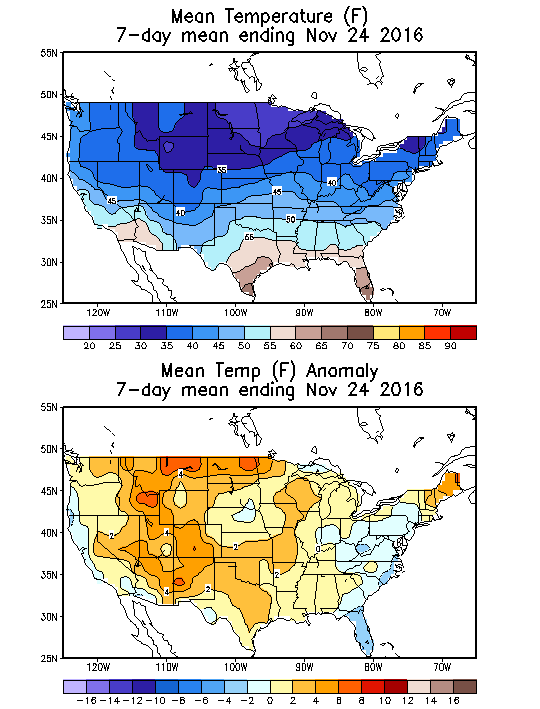
Source: NOAA National Weather Service
Deviation between average and normal (°F)
7-Day Mean ending Nov 24, 2016

Source: NOAA National Weather Service

